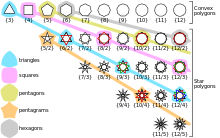Regular polygon
A regular polygon, regular polygon, regular polygon, regular polygon or isogon (from Greek ἴσος, equal and γωνία, angle) is, in geometry, a plane polygon that is both equilateral and equiangular. Thus, for a regular polygon, all sides are equal in length and all interior angles are equal in size. The corners of a regular polygon all lie on a common virtual or real circle, with adjacent corners appearing at the same central angle.
Regular polygons can be simple or overlapped. Simple regular polygons are always convex. Overlapped regular polygons are called regular asterisk polygons. The symmetry group of a regular 



All parameters of regular polygons, such as the length of the diagonals, the perimeter or the area, can be specified using trigonometric functions. However, not all regular polygons can be constructed with compass and ruler. Regular polygons are used, among other things, in the approximation of the circle number π 
Definition
A polygon with 



holds. Thus, in a regular polygon, all sides are congruent to each other and all angles are equal.
Classification
A distinction is made between simple and overlapped regular polygons. All simple regular polygons with the same number of vertices are similar to each other and are 

- the equilateral triangle
,
- the square
,
- the regular pentagon
and
- the regular hexagon
.
Overlapped regular polygons are called regular star polygons and have a greater variety of shapes. They are 


- the five star
,
- the seven-pointed stars
and
and
- the eight-pointed star
.
Thus, the number of different types of regular polygons with 








Designations of regular polygons and other star shapes
Search within the encyclopedia
